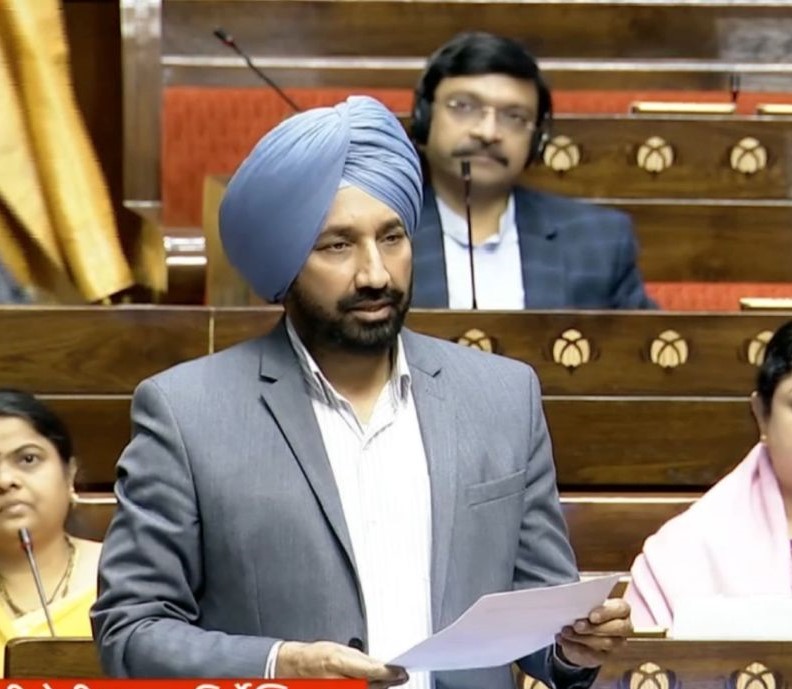Solar power generation in Punjab has doubled (from 1358 million units to 2673 million units) in the last 5 years (2019 to 2024). This information was given by Rajya Sabha member Satnam Singh Sandhu during the ongoing winter session of the Parliament in response to a question regarding the steps taken by the Ministry to promote the production of new and renewable energy in Punjab during the last 5 years. Shripad Yeso Naik, Minister of State for Renewable Energy and Power shared.
MP Sandhu raised the question about the amount of green or renewable energy produced in the state during the last five years along with the steps taken by the ministry to promote production of new and renewable energy in Punjab. He also asked questions about the steps taken by the Union Ministry to use farm waste and other agricultural waste to generate green energy in the country, especially in Punjab.
According to the data shared by the Union Minister on new and renewable energy production in Punjab, there has been a 54 percent increase in biomass gas production in Punjab during this period, which has increased from 398.37 million units to 613.44 million units. According to the data, the total production of new and renewable energy generation including solar, biomass, bagasse, small hydro power, large hydro in the state has increased by 12 percent in the last 5 years, which increased from 7846 million units to 8798 Million units have been reached.
Giving details of the steps taken by the Ministry of New and Renewable Energy to promote and accelerate renewable energy capacity in the country including Punjab, the Union Minister said that 16 projects in Punjab under the National Bioenergy Program by MNRE in November 2022. are notified which use agricultural waste including paddy straw as their feedstock.
He said, “This program provides Central Financial Assistance (CFA) in the country including Punjab state for biomass related projects like compressed biogas (CBG) plants, non-baggage co-generation plants. and assists in setting up briquette/pellet manufacturing plants. These biomass plants use agricultural waste including paddy straw as one of their feedstocks. So far 16 projects have been started under this program in Punjab.
According to data, in July 2024, MNRE increased the CFA for manufacturing non-terrified and terrified pellets in the country, including Punjab, to Rs 21 lakh/MTPH (metric ton per hour) or 30 per cent of the capital cost per MTPH and Rs 42 lakh respectively. /MTPH or 30 percent of the capital cost per MTPH.
The Union Minister said that in order to realize the commitment of 500 GW of non-fossil energy capacity by 2030, several plans and initiatives have been taken by the government to promote and accelerate renewable energy capacity in the country. He said that foreign direct investment (FDI) has been allowed up to 100 per cent under the automatic route and inter-state transmission for inter-state sale of solar and wind power for projects to be commissioned by June 30, 2025. System (ISTS) charges have been waived and charges have been waived for green hydrogen projects till December 2030 and for offshore wind projects till December 2032. are given
Nel said that R.E. To boost consumption, Renewable Purchase Obligation (RPO) followed by Renewable Consumption Obligation (RCO) trajectory has been notified till 2029-30.
He said that Pradhan Mantri Kisan Energia Suraksha Avum Utthan Mahabhiyan (PMKUSUM), “Pradhan Mantri Surya Ghar Free Power Scheme”, High Efficiency Solar PV Schemes like National Program on Module, National Green Hydrogen Mission, Viability Gap Funding (VGF) scheme for offshore wind projects have been launched.
Large scale R.E. RE for setting up projects. A plan to set up “Ultra Mega Renewable Energy Parks” is being implemented to provide land and transmission to developers.
Member of Parliament (Rajya Sabha) Satnam Singh Sandhu lauded the central government led by Prime Minister Modi for India’s remarkable growth in renewable energy. He said that India is not only witnessing an energy revolution but is also becoming the renewable energy capital of the world.
“Under the leadership of Prime Minister Narendra Modi, India is currently one of the most promising countries in the world in the clean energy sector. Between April and November of the current fiscal year, India added about 15 GW of renewable energy capacity, almost double the 7.54 GW added in the same period last year.”
He further said that India’s total installed capacity in the non-fossil fuel energy sector has reached 214 GW, which represents an increase of over 14% over the same period last year.
The Rajya Sabha member said that 2.3 GW of new capacity was added in November 2024 alone, representing a four-fold increase from the 566 MW added in November 2023. He said, “Despite being one of the largest sources of coal globally, India has the lowest per capita emissions, at one-third of the global average. The ongoing transformation in India’s energy sector is driven by the strong belief that achieving a Sustainable India by 2047 is intrinsically linked to sustainable and green growth.”
He said that RE in India by the central government. Several important steps have been taken to boost the growth of the sector such as the launch of the Production-Linked Incentive (PLI) scheme, which aims to boost domestic solar panel and module manufacturing at a cost of Rs 24,000 crore. An ongoing initiative is also underway to set up 50 solar parks with a cumulative capacity of 38 GW by 2025-26.
“Furthermore, arrangements have been made to announce the trajectory for the Renewable Purchase Obligation (RPO) till the year 2029-30,” he said. The “Pradhan Mantri Surya Ghar Mufta Bijlee Yojana” is targeting 1 crore installations by 2026-27 at a cost of Rs 75,021 crore.

